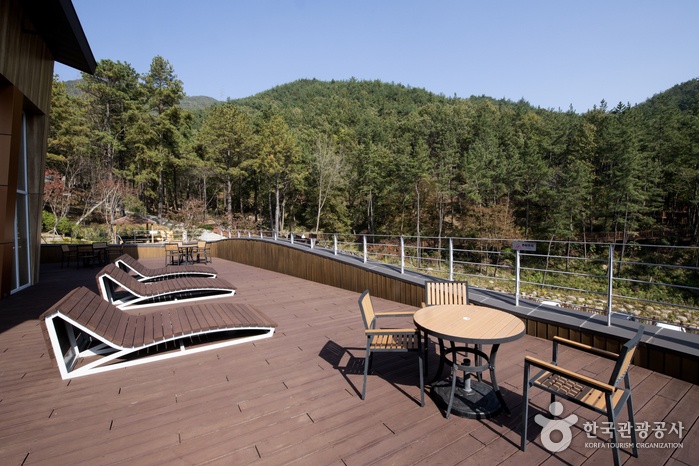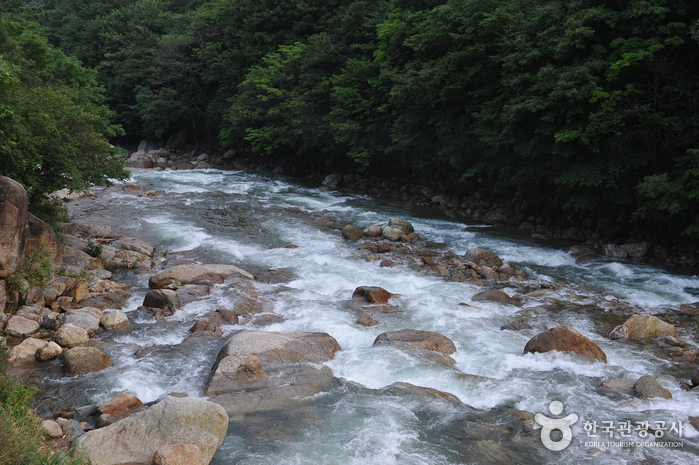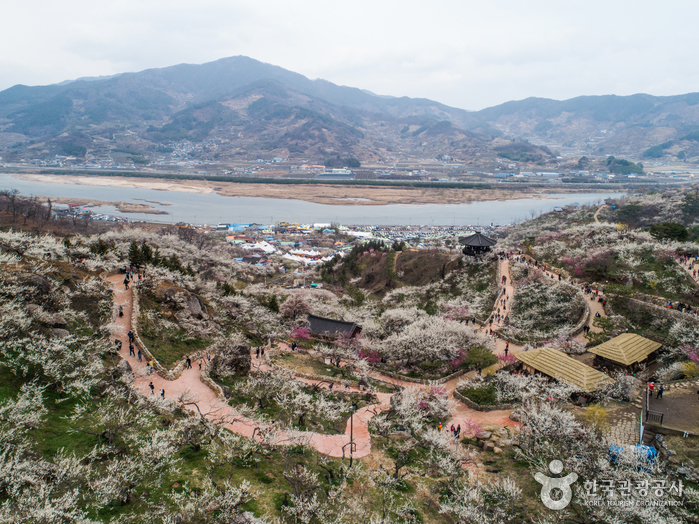Baegunsan Recreational Forest (백운산자연휴양림)
.0M 2024-02-01
337 Baekgye-ro, Gwangyang-si, Jeollanam-do
+82-61-797-2655
Located in Baegunsan Mountain is a recreational forest that is a testament to Korea's rich ecosystem. Home to many rare fauna and flora, the area brims with diverse attractions. Come springtime, visitors can find the maple sap, a mineral-rich liquid from a local deciduous tree of the maple family, known for its medicinal benefits. Indeed, this is a recreational forest cradled in the arms of nature. With the towering Baegunsan peak, scaling 1,222 meters, as its crown jewel, the landscape unfolds like a tapestry woven with harmonious blends of man-made and natural pine forests. Journey through the cedar and cypress woods, and one will find the valley that evokes sheer wonder. Close by, history whispers through the ancient Ongnyongsa Temple Site, where Doseonguksa dedicated 35 years to ascetic practices. As February turns to March, over 7,000 camellias blossom around this sacred site, painting the area in vibrant hues.
Baegunsan Mountain Donggokgyegok Valley (백운산 동곡계곡)
3.1Km 2021-04-23
154, Yaksujedan-gil, Okryong-myeon, Gwangyang-si, Jeollanam-do
+82-61-797-3333
Donggokgyegok Valley is one of four large valleys on Baegunsan Mountain. The valley opens up towards Gwangyang, with the waters of Dongcheon Stream flowing into Gwangyangman Bay. Donggokgyegok Valley is wide, making it convenient for transportation, and perfect for a family getaway during the holidays. Located along Hanjae Pass between the mountain summit and Ttoaribong Peak on the west side, the valley is also sometimes called Dapgoksimni. The valley stretches a distance of 10 kilometers and is especially beautiful in fall when surrounded by vibrant autumn foliage. Donggokgyegok Valley is a protected nature reserve with over 900 various species of vegetation.
Peepul Hanokstay (연경당)
4.1Km 2024-08-05
13-40 , Jungheung-ro, Gwangyang-si, Jeollanam-do
+82-10-4665-9301
Yeongyeongdang in Gwangyang-si, Jeollanam-do, is a sunny hanok stay set in beautiful scenery with Baekun Reservoir in front and Baekun Mountain behind. Each room has a bathroom with bathtub, traditional ondol heating plus boiler, an AC unit and glass doors and windows to keep it cozy. Cooking is done in the common kitchen, with an outdoor barbecue also available. There is no supermarket nearby, so visitors should bring food with them. (There are vending machines for snacks and drinks in the kitchen.)
Baegunsan Eochigyegok Valley (백운산 어치계곡)
7.8Km 2021-06-01
531, Baekhak-ro, Gwangyang-si, Jeollanam-do
+82-61-797-3333
Eochigyegok Valley, located in Eochi-ri, Jinsang-myeon, is 7 kilometers long, and is a valley with clear water flowing through the lush forest with rocks in all sizes that provide a resting spot. In particular, it is home to Orodae Rock, cool enough to form dew even in the middle of the day and Gusipokpo Falls with a legend of a flying horse.
The valley is located ten minutes away from the Seomjingang River Maehwa Village, and plum trees cover the valley in spring with plum blossoms. In autumn, the countless oak trees in the forest become an acorn factory for its habitats. Baegunsan Eochigyegok Valley is worth visiting at any time of the year and provides various agricultural products to local residents. Orodae Rock, located in the uppermost stream, refers to a rock that looks like a large courtyard. An inscription remains, saying that it is named Orodae because it is cool enough to form dew even in the midday of the summer. Legend says that Gusiso Pool at the base of Gusipokpo Falls is so wide that it will not dry up even in a draught.
Geum Mok Seo (금목서 광양불고기)
8.3Km 2024-03-08
199 Eupseong-gil, Gwangyang-eup, Gwangyang-si, Jeollanam-do
Geum Mok Seo is a restaurant specializing in Gwangyang-style bulgogi, a local delicacy. Gwangyang bulgogi is made by thinly slicing pork brisket, marinating it, and grilling it over charcoal. It is known for its unique sweet and savory marinade, and it's even more delicious when enjoyed with the generous spread of 13 side dishes. Located just a 5-minute drive from Gwangyang Express Bus Terminal.
Gwangyang Wine Cave (광양와인동굴)
10.1Km 2024-02-01
33 Gangjeong-gil, Gwangyang-eup, Gwangyang-si, Jeollanam-do
Opened in July 2017, the Gwangyang Wine Cave has transformed the historic Gwangyang Steel Cargo Transportation Tunnel into an immersive wine and cultural experience. Spanning 301 meters in length, 4.5 meters in x_width, and 6 meters in x_height, this unique space aims to introduce the world of wine to aficionados and novices alike. Here, visitors can journey through the global wine collections, gradually cultivating a deeper appreciation for this age-old beverage. In addition, the cave delights visitors with its diverse attraction. Visitors can revel in the cozy wine cafeteria, be mesmerized by the dynamic media façade video show, and snap quicky memories at the trick art photo zone. For those keen on hands-on experiences, the art of plum wine-making plum awaits. And for the perfect memento, an exclusive space offers Gwangyang's special products for purchase.
Gwangyang Wine Cave also manages Gwangyang Eco Park, situated on the left side of the wine cave entrance after parking. This park offers a space where children can immerse themselves in media ecology, sparking their imagination and creativity. The experience center is designed for year-round enjoyment, maintaining a temperature suited for all four seasons.
LF Sqare Terrace Mall - Gwangyang Branch [Tax Refund Shop] (LF스퀘어테라스몰광양점)
10.3Km 2024-04-16
466, Sungwang-ro, Gwangyang-eup, Gwangyang-si, Jeollanam-do
-
Cheong Maesil Farm (홍쌍리 청매실농원)
10.8Km 2024-02-01
55 Jimak 1-gil, Daap-myeon, Gwangyang-si, Jeollanam-do
Cheong Maesil Farm sprawls across an expansive area of over 165,000 m2 at the foothills of Baegunsan Mountain, which rises to an elevation of 1,217 meters. The farm has been lovingly tended to by the renowned Plum Blossom Doctor, Hong Ssang-ri, for decades, drawing visitors from all over the country. In March, Cheong Maesil Farm transforms into a breathtaking canvas of colors—with blue and red plums, the delicate lily trees and the vibrant cornelian cherries all blossoming in unison. For photo enthusiasts, the farm boasts a dedicated photo zone, while the Pavilion Observatory offers panoramic views that are a favorite among visitors. From this spot, one can marvel at the picturesque scenery of Gwangyang Maehwa Village, Seomjingang River, and Hadong Village on the river’s other side. Visitors in spring are recommended to attend the annual plum festival centered around Cheong Maesil Farm. Moreover, the nearby Gwangyang Plum Culture Center makes for an enriching stopover.
Gwangyang Maehwa Village (광양 매화마을)
10.9Km 2025-01-08
1563-1 Seomjingangmaehwa-ro, Gwangyang-si, Jeollanam-do
+82-61-772-9494
Following the Seomjingang River flowing down the outskirts of Jirisan Mountain is a village filled with plum trees. This village, Seomjin Village, is also known as the Maehwa (plum) Village for its abundant number of plum trees. Instead of crops and grains, plum trees are cultivated on farmlands, boasting white snow-like blossoms in March and bearing ripe plums in June. The annual Plum Blossom Festival takes place in the village every March when the plum blossoms are in full bloom.
ER NC Department Store - Suncheon Branch [Tax Refund Shop] (ER NC백화점 순천)
11.2Km 2024-04-23
22, Bibong 2-gil, Suncheon-si, Jeollanam-do
-






![LF Sqare Terrace Mall - Gwangyang Branch [Tax Refund Shop] (LF스퀘어테라스몰광양점)](http://tong.visitkorea.or.kr/cms/resource/91/2886391_image2_1.jpg)


![ER NC Department Store - Suncheon Branch [Tax Refund Shop] (ER NC백화점 순천)](http://tong.visitkorea.or.kr/cms/resource/98/2886398_image2_1.jpg)
 English
English
 한국어
한국어 日本語
日本語 中文(简体)
中文(简体) Deutsch
Deutsch Français
Français Español
Español Русский
Русский